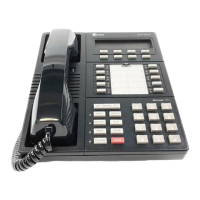The 8510T voice terminal components pictured in Figure 1, the top view,
are described below and on the next page. For your convenience, they
are listed alphabetically.
Call appearance/feature buttons
These 10 buttons are devoted
either
to
handling incoming and outgoing calls (call appearances) and are labeled
with the exchange (numbers) and extension number
or
they can be used
as feature buttons to access voice features such as Call Forward or
Send All Calls; these are labeled with the feature name. Each of these
10 call appearance/feature buttons has a red light, which indicates the
selected line
and a green light which indicates the
status of that line or
feature
.
Conference button
For setting up conference calls with an additional
party.
Designation card
For noting the call appearance telephone number or
extension or feature that the button can access.
Dial pad
The standard 12-button pad for dialing telephone numbers
and accessing features. The letters, "Q" and "Z," have been added
to the appropriate dial pad keys for entering directory names, and
the "5" button on your dial pad has raised bars for visually-impaired
users.
Display control buttons
These 4 buttons are labeled Menu, Dir,
< Prev, and Next > .
d
The
cbbbbbbc
bbbbbb
Menu
button is used to access the main softkey menu.
d
The
cbbbbc
bbbb
Dir
(Directory) button allows you to quickly access Directory
entries in order to place a call.
d
The
cbbbbbbbc
bbbbbbb
< Prev
and
cbbbbbbbc
bbbbbbb
Next >
buttons can be used to help you go back
and forth through menu options, to search for an entry in your
Directory, and to view entries in your Call Log.
Drop button
For disconnecting from a call or dropping the last party
added to a conference call.
Exit button
For exiting a display feature and returning to normal call-
handling mode.
Handset
For placing and answering calls (often people call it the
receiver).
Hold button
A red button, for putting a voice call on hold.
4

